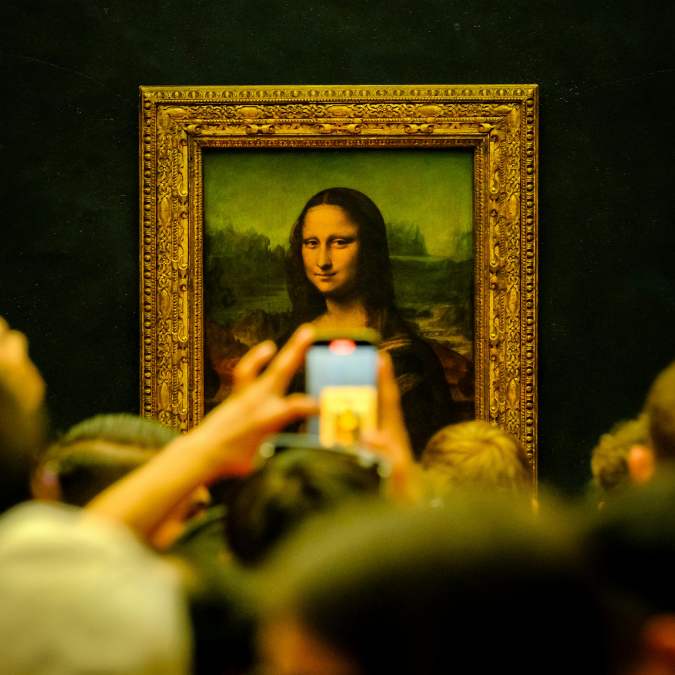
The Art Heist That Changed History Forever
Few art crimes have ever captured the public’s imagination like the theft of the Mona Lisa. When the world’s most famous painting vanished from the Louvre Museum in Paris on August 21, 1911, panic spread through France and beyond. Crowds gathered in disbelief before the empty space where Leonardo da Vinci’s masterpiece had once hung. Newspapers around the globe ran headlines screaming “The Mona Lisa Is Missing!”
The man behind this extraordinary theft wasn’t a professional criminal or a mastermind art dealer. He was a humble Italian handyman named Vincenzo Peruggia, driven by a strange mixture of patriotism, opportunity, and luck. 🇮🇹
This is the story of how and why a simple worker managed to steal one of the most valuable artworks in history, how the world reacted, and how the theft transformed the Mona Lisa from a masterpiece into a global icon.
🖼️ A Masterpiece Before the Crime
Before its theft, the Mona Lisa was certainly admired — but it wasn’t yet the most famous painting in the world.
Painted by Leonardo da Vinci between 1503 and 1506, the Mona Lisa (or La Gioconda) was part of the French royal collection since the 16th century, acquired by King Francis I. It hung quietly in the Louvre for centuries, attracting art lovers and scholars, but not the massive crowds we see today.
Everything changed on that fateful summer morning in 1911.
🧰 Who Was Vincenzo Peruggia?
Vincenzo Peruggia was born in 1881 in Dumenza, a small town near the Italian-Swiss border. Like many Italians at the time, he moved to France in search of work.
In Paris, Peruggia found employment at the Louvre Museum, where he worked as a glass installer. Ironically, his job was to help protect paintings — including the Mona Lisa — by fitting them with protective glass panels.
He wasn’t a thief by trade. He had served in the Italian army, was reportedly quiet and hardworking, but also deeply proud of his Italian heritage. That pride would later become the justification — or the excuse — for one of the boldest art thefts in history.
⏰ The Day the Mona Lisa Disappeared
It was Monday, August 21, 1911, a day when the Louvre was closed for cleaning and maintenance.
Early that morning, Vincenzo Peruggia entered the museum wearing a white worker’s smock, identical to the uniforms worn by other maintenance staff. No one suspected anything. He had access to the building from his former work as a handyman and knew its layout perfectly.
Peruggia walked into the Salon Carré, where the Mona Lisa hung among other Italian masterpieces. He carefully lifted the painting off the wall, carried it to a nearby stairwell, and removed its frame and protective glass.
Then, he simply hid the painting under his clothing — some say he concealed it under his smock — and walked out of the museum unnoticed.
🚶♂️ Just like that, the world’s most famous painting was gone.
😱 The Discovery and the Panic
The theft wasn’t noticed immediately.
On Tuesday, August 22, an artist visiting the museum to paint noticed the Mona Lisa missing and assumed it had been taken to be photographed. Hours later, a museum guard realized the painting wasn’t anywhere in the building.
When the truth became clear, chaos erupted. The Louvre closed for a week. Detectives, journalists, and curious Parisians flooded the museum.
Crowds lined up — not to see the Mona Lisa, but to stare at the empty space where she had once hung. Newspapers called it “the theft of the century.”
The French police were humiliated. The public demanded answers.
🔍 The Investigation: Picasso, Apollinaire, and the Wrong Suspects
The case took bizarre turns from the very beginning.
The French police, led by Alphonse Bertillon, had little to go on. There were no witnesses, no fingerprints, and no ransom demands.
In their desperation, investigators turned their attention to the Parisian avant-garde — artists and intellectuals who often mocked traditional art.
Among those questioned were Guillaume Apollinaire, the poet, and his friend Pablo Picasso, who had once owned some stolen sculptures from the Louvre (though unrelated to the Mona Lisa).
Both men were interrogated but eventually released. The real thief, meanwhile, was quietly living in a small Paris apartment — with the Mona Lisa hidden in a trunk under his bed. 😮
🏠 Two Years in Hiding
For two long years, the Mona Lisa remained missing.
Peruggia kept the painting carefully wrapped in a cloth inside a wooden trunk. He later claimed that he wanted to return the artwork to Italy, believing it had been stolen by France when Leonardo moved there under the patronage of King Francis I.
His story was part patriotism, part delusion. In reality, the Mona Lisa had been legally acquired by the French crown centuries earlier. But Peruggia truly seemed to believe he was doing something noble — reclaiming Italy’s artistic heritage. 🇮🇹
He waited for the right moment to “restore” the painting to its homeland.
✈️ The Capture in Florence
In December 1913, after more than two years of silence, Peruggia finally made his move.
He contacted Alfredo Geri, an art dealer in Florence, offering to sell the Mona Lisa for a “modest reward.” Suspicious yet intrigued, Geri arranged a meeting at his gallery.
When Peruggia arrived, he proudly produced the painting from a false-bottomed trunk. Geri and Giovanni Poggi, the director of the Uffizi Gallery, immediately recognized it as genuine — and discreetly alerted the police.
🚔 Peruggia was arrested on the spot.
When questioned, he calmly explained that he had acted “out of love for Italy.” He expected to be hailed as a national hero.
And in some ways, he was.
⚖️ The Trial and the Public Reaction
Peruggia’s trial took place in Florence in 1914, and his defense — that he had stolen the painting out of patriotism — touched a chord with the Italian public.
Many Italians saw him not as a criminal but as a patriotic fool who had done what museums and governments could not: bring La Gioconda back to her homeland, if only for a short time.
Even the court showed leniency. He was sentenced to just one year and fifteen days in prison — and served only seven months.
After his release, he returned to France, fought for Italy during World War I, and later opened a paint shop. He lived quietly until his death in 1925.
🖌️ The Mona Lisa’s Triumphant Return
After its recovery, the Mona Lisa toured several Italian cities — Florence, Rome, and Milan — where thousands came to see the legendary painting that had “come home.”
Then, under heavy security, it was returned to France, where it remains today at the Louvre Museum in Paris.
The theft had transformed it forever.
Before 1911, the Mona Lisa was admired by artists and scholars. After 1911, she became a global celebrity — a symbol of mystery, intrigue, and timeless beauty. The theft made her famous in a way that no exhibition or art critic ever could.
🧩 Why Did He Do It? Motives Behind the Theft
Historians and criminologists have long debated Vincenzo Peruggia’s true motives.
Was he a thief driven by greed, or a patriot blinded by nationalism?
The most likely answer is a mix of both.
- Patriotism: Peruggia genuinely believed that La Gioconda belonged in Italy.
- Opportunity: His knowledge of the museum and its routines made the theft possible.
- Ego and recognition: He may have wanted to be remembered — not as a criminal, but as a hero who restored Italy’s pride.
Whatever his reasons, the theft revealed something fascinating about how people value art — not only for beauty or history, but for national identity and emotion.
🧠 The Psychological Side: The Ordinary Man Who Outsmarted a Museum
From a criminological point of view, the Mona Lisa theft is unique.
There was no violence, no high technology, and no elaborate plan — just simplicity, access, and timing.
Peruggia used his insider knowledge, not cunning or brutality. He exploited the museum’s weak security — there were no alarms, cameras, or guards in every room.
In psychological terms, his crime fits the profile of the “moral thief” — someone who convinces himself that his act, though illegal, serves a higher purpose.
This moral justification helped him overcome guilt and fear. He didn’t see himself as a criminal but as a patriot performing a noble act.
🌍 A Theft That Changed the Art World
The 1911 theft of the Mona Lisa had profound consequences.
1. It Revolutionized Museum Security
The Louvre — and museums worldwide — drastically improved their security systems after the incident. The idea that a world-class museum could lose its most valuable painting was unthinkable.
2. It Turned the Mona Lisa into a Cultural Icon
Before 1911, the Mona Lisa was respected. After 1911, she was legendary. The theft transformed her into a myth, inspiring countless books, films, and artistic parodies.
3. It Exposed the Media’s Power
The press coverage was enormous — daily headlines, sketches, and speculation kept the story alive for years. The media frenzy made the painting a symbol of mystery and intrigue, feeding her enduring allure.
🎭 The Legacy of Vincenzo Peruggia
Today, Vincenzo Peruggia is remembered as one of history’s most unusual thieves — not for his skill, but for his strange, almost romantic motive.
His theft stands out not as an act of greed, but as a story of naive patriotism and human folly.
He didn’t profit from the painting. He didn’t harm anyone. In fact, his crime arguably helped the Mona Lisa become the world’s most famous painting.
A century later, her smile continues to fascinate — and his story continues to remind us that even a humble worker can, for a moment, change the course of history. 🕰️✨
📚 Sources
- Sassoon, Donald. Becoming Mona Lisa: The Making of a Global Icon. Harcourt, 2001.
- Bailey, Martin. The Theft of the Mona Lisa: On Stealing the World’s Most Famous Painting. 2013.
- Nicholas, Lynn H. The Rape of Europa: The Fate of Europe’s Treasures in the Twentieth Century. Vintage, 1995.
- Louvre Museum Archives, Paris.
- BBC History, “The Man Who Stole the Mona Lisa” (2021).

